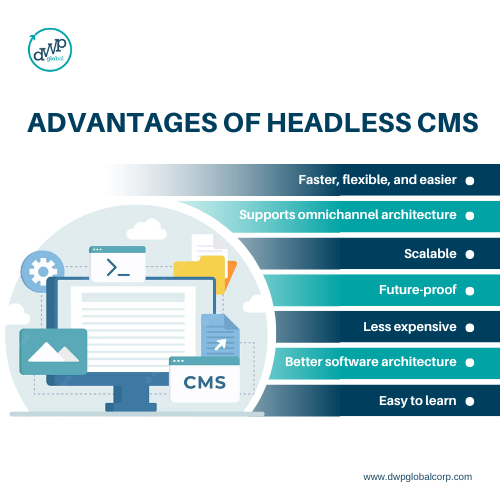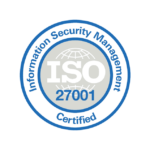- By: Admin
- June 9, 2023
- 1283 views

A content management system usually manages the content on digital properties and creates and alters digital content. It is commonly used for digital signage, enterprise, and web content management.
A headless CMS stores content on the back end and shares it with mobile apps via API (application programming interface) for display on any device. It separates the front-end rendering from the back-end, allowing content to be shown in any format. Content is stored centrally and made available as a service for any application on any platform without compromising performance.
Let us know in detail what a headless CMS is and why we must use one.
What Is A Headless CMS
A headless CMS (decoupled CMS) is a system whose content repository doesn’t have any front-end components to determine how the content is presented to end users. The content can be published anywhere through a well-defined API (application programming interface) for multiple platforms and channels.
By removing the presentation layer or “head” from the CMS, there are no restrictions on how and where rich content can be delivered, providing a great customer experience on devices such as mobiles, desktops, smart fridges, smart watches, IoT industrial devices, and more.
The best software development company assists firms with end-to-end solutions.
How A Headless CMS Works
A headless CMS is a tool that allows editors and marketers to input content through an interface. It stores the content in small, organized blocks and provides a RESTful API (JSON, XML) to deliver to various channels and devices. The CMS does not concern itself with how or where the content is delivered.
However, the delivery process can be broken down into three basic steps:
- Editors and marketers input the content into the CMS.
- The content is stored in small blocks, ready for delivery.
- Front-end and mobile developers can use their preferred framework to design and present the content in the best way possible for different channels and mediums.

Advantages Of Using Headless CMS
A headless CMS content publishing platform offers flexibility, enabling seamless integration with other systems. With a low learning curve, it’s easy for you to get started. You can also create reusable content that can be utilized across multiple channels. Software vendors take care of CMS security and management so that you can focus on delivering content and other important tasks. You can efficiently enhance your website’s performance by utilizing the headless management platform.
Here are some key benefits that you can enjoy by using the headless CMS platform:
1. The headless CMS approach is faster, more flexible, and easier
With a headless CMS, you can choose your preferred programming language. The CMS is API-driven, allowing you to create the presentation layer on the same back-end or front-end from start to finish. There are no proprietary development constraints, so your developers can work their usual way. Additionally, a single content item can be reused in several different presentation outputs and combined with various outputs, resulting in quicker project completion. A webhook is a user-defined HTTP callback or code snippet that triggers action-specific events in a web application.
Integrating a headless CMS with your existing systems, including webhooks, is simple and secure. For example, you can set up a webhook to notify users via email after they’ve subscribed to your site. This CMS’s flexibility allows developers to build any code for any integration without a fixed structure or coding restrictions. The CMS’s flexibility is beneficial from a resourcing point of view and for integrating with more complex systems.
2. Headless CMS supports omnichannel architectures
Marketers face a significant challenge with omnichannel, as they must create compelling content that stands out across all touchpoints. However, managing each channel can be time-consuming and challenging. That’s where a headless CMS comes in. It provides the ability to create a seamless experience across all touchpoints, ensuring consistency and relevance. With the increasing number of digital touchpoints and languages to update, a headless CMS removes these common barriers and makes it easier for marketers to succeed.
3. Headless CMS is more scalable
By separating the back-end and front-end, any performance issues or maintenance needs with the headless architecture back-end CMS platform will not cause any downtime or compromise the performance of your website. With a headless CMS, you have unlimited hosting options and deployment environments, and it’s a great way to ensure optimal performance and minimize disruptions.
4. Headless CMS is future-proof
A headless CMS separates the presentation layer from the data and logic layer, future-proofing applications and simplifying content structuring. It allows for re-branding without technical changes within the CMS and can be selectively adopted and integrated into digital platforms using APIs.
5. Headless CMS costs less
A headless CMS separates the presentation layer from the data and logic layer, future-proofing applications and simplifying content structuring. It allows for re-branding without technical changes within the CMS and can be selectively adopted and integrated into digital platforms using APIs.
6. Headless CMS leads to better software architecture
Headless CMS separates the CMS platform from published content, improving software architecture and security. CMS access to publishing tools storing content is restricted internally, while published content is either approved for public consumption or secured/encrypted. It also allows for easy scalability and ensures high availability in downtime applications.
7. Headless CMS is easier to learn and use
Most people would concur that the most notable advantage of using a headless CMS is the simplicity and swiftness of handling the content. This approach to CMS implementation is more streamlined, as the CMS tool is exclusively utilized for managing content and storage without unnecessary features or editing tools irrelevant to business users and other resources.
8. Headless CMS allows one to focus on business
Focusing all your energy on creating content and managing your CMS can distract you from expanding your business. A conventional CMS may consume a considerable amount of your valuable resources.
9. With a Headless CMS, having a smaller team that doesn't need to be as specialized is possible.
Managing content is no longer as expensive and difficult as it used to be with traditional CMS architecture. Nowadays, companies do not need to hire specialized consultants with extensive knowledge of a specific CMS. While some expertise is still necessary, it is more demanding than it was before.
How DWP Global Corp Assists in Headless CMS Solution
DWP Global Corp, the best software development company, is a reliable technology partner for businesses looking to embrace digital transformation. Their customized solutions integrate state-of-the-art technologies, business intelligence tools, and no-code/low-code platforms to help companies become fully digital and data-driven.
The DWP Global Corp follows the best practices in technology to provide end-to-end services for application design, integration, and maintenance, whether it’s a customer-facing app or a game-changing enterprise solution. They ensure that every aspect of the app development process, from inception to delivery and ongoing support, is handled with utmost care and attention for a smooth customer journey.

